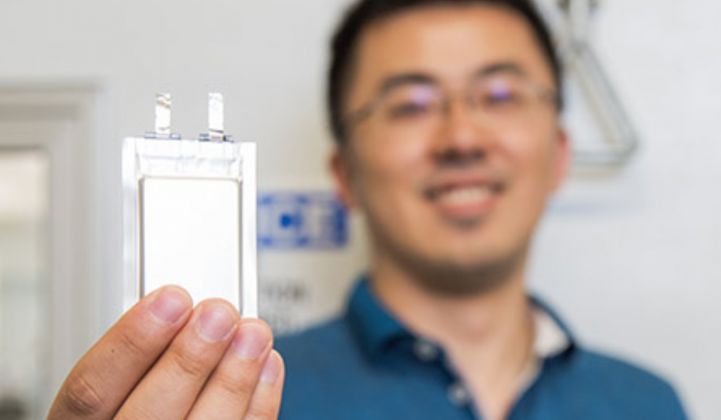A Massachusetts-based startup says it’s doing something that no other company has been able to pull off: selling lithium-metal batteries commercially.
And they’re appearing first in drones.
SolidEnergy Systems, a spin-out from MIT, has developed a battery that it says has double the energy density of current lithium-ion batteries. That means that a battery from SolidEnergy Systems could be half the size of a standard lithium-ion battery and hold the same amount of energy, or it could be the same size as a lithium-ion battery and hold twice as much energy.
For drone makers, that means a drone could fly farther and longer on a single charge. For example, a drone surveying acres of crop land could fly for an hour instead of just 20 minutes with a standard battery.
The company’s battery can “double the radius” that a drone can fly, and “quadruple the area covered,” said SolidEnergy Systems CEO and founder Qichao Hu, who developed the technology at MIT in the lab of battery researcher Don Sadoway.
Hu said the company is now selling batteries in low volumes to drone makers and companies that are looking to bring wireless internet to rural areas.
SolidEnergy Systems just closed on a funding round of $34 million. While the startup didn’t disclose its investors in the Series C round, existing investors include Temasek, Applied Ventures, General Motors and Vertex Ventures China.
The company, founded in 2012, has raised $50 million to date. That’s not a lot of capital to get a battery from the lab into a factory. The new funding will be spent on improving the battery tech and expanding manufacturing.
SolidEnergy System’s energy storage innovation is packed into a thin lithium-metal foil for the negative electrode, replacing the graphite that is commonly used in lithium-ion batteries.
The company’s batteries also use a semi-solid material for the electrolyte, replacing the flammable liquid usually found in lithium-ion batteries. The two-part breakthrough creates a battery with an energy density of 450 watt-hours per kilogram and 1,200 watt-hours per liter.
A recent report in the journal Nature, written by government scientists, suggests that the combination of the lithium-metal battery and a solid electrolyte could lead to a successor to the lithium-ion battery. The paper predicts that such batteries are at least a decade away.
However, SolidEnergy Systems is already selling batteries in low volumes today. Hu said the Nature paper is focused on the “perfect” battery, while batteries that are “good enough” are already arriving.
SolidEnergy System’s battery is more expensive than a lithium-ion battery. That’s largely because the new batteries are made in small volumes, said Hu. But drone makers are paying the premium in order to boost their flying times.
Down the road, Hu said the company’s lithium-metal battery will be the same cost as a lithium-ion battery. The Nature paper finds that with the right low-cost parts, lithium-metal battery cells could reach a cost of $100 per kilowatt-hour.
While SolidEnergy Systems has reached a sales milestone, it’s still selling the drone batteries in low volumes that are manufactured in its showcase factory in Woburn, Massachusetts. At some point, the company plans to scale up manufacturing in Asia -- either China or Korea -- according to Hu.
The company is trying to keep manufacturing costs low by making lithium-metal batteries on standard equipment used by the lithium-ion battery industry. The very first factory (built before the one in Woburn) used old manufacturing equipment secured from A123 Systems after that company's bankruptcy.
Drones are just the first market for SolidEnergy Systems. The company is aiming to build battery packs for wearables, like smart watches, and eventually for electric vehicles. “The end goal is to disrupt transportation,” said Hu.
Commercializing a new type of battery is exceedingly difficult. Previously, SolidEnergy Systems predicted its drone and wearable batteries would be available last year and its electric car battery would be ready in 2018. Hu now estimates the company’s wearable battery will be ready in 2019, and its EV battery will arrive sometime in 2020 or 2021.




